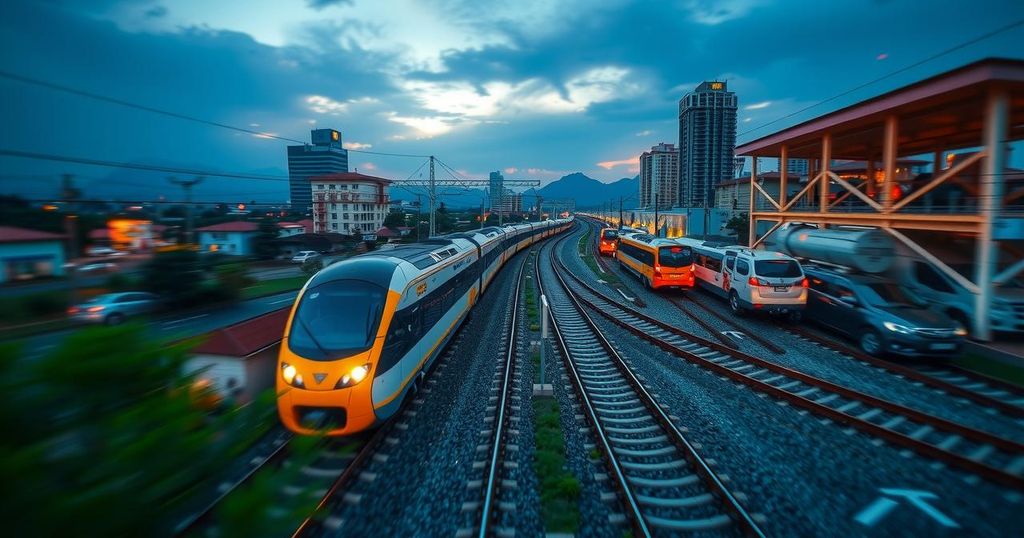Indonesia Seeks Chinese Investment for High-Speed Rail Expansion
Indonesia is actively seeking Chinese investment to extend its high-speed railway, Whoosh, from Jakarta to Surabaya. The project, part of Indonesia’s broader infrastructure strategy under the Belt and Road Initiative, is expected to significantly reduce travel time. Experts predict economic benefits from this extension and emphasize the importance of diversifying investment sources to avoid over-reliance on China. The government is also encouraging private sector participation through public-private partnerships.
Indonesia is currently seeking enhanced investment from China to extend its recently inaugurated high-speed railway line, known as Whoosh, which connects Jakarta to Bandung. This initiative is part of a broader strategy by the Indonesian government to further develop its rail infrastructure under the framework of the Belt and Road Initiative (BRI). The Whoosh has successfully served over four million passengers in its inaugural year, prompting the government to consider an extension of the line to Surabaya, East Java, aiming to reduce travel time from Jakarta to Surabaya from eight hours to just four. Danang Parikesit, a transport policy expert from Gajah Mada University, emphasized the economic benefits of this extension, noting its potential to enhance economic integration across Java and boost growth in the services and trade sectors. In pursuit of further investments, Indonesia showcased three major railway projects at a rail expo in Shanghai. These include plans to connect the Whoosh to urban rail systems in Bandung, develop an airport line in Nusantara, and establish an urban rail network linking Nusantara with surrounding cities. The Ministry of Transportation has indicated that the Bandung railway project promises substantial returns, projecting an investment return rate of 11.9%, supported by a government viability gap fund that will cover nearly half of the costs. Director General Risal Wasal stated that the government welcomes private investors to engage in a public-private partnership for the development of this infrastructure. In addition, China has been involved in other transportation projects within Indonesia, including a newly launched Autonomous Rail Rapid Transit system in Nusantara and potential light rail transit systems in Bali. However, Danang cautioned against becoming overly reliant on Chinese investment, advocating for a diversified international partnerships approach to ensure sustainable growth in Indonesia’s transportation sector. Experts point out that China is increasingly taking a leading role in Indonesia’s railway development, overshadowing Japan’s historical contributions. While Japan has offered financial assistance with certain conditions, China presented more favorable terms that included technical knowledge transfer without extensive prerequisites. Recent agreements between PT Kereta Commuter Indonesia and China’s CRRC demonstrate this growing partnership, highlighting significant train procurement to meet the expanding operational needs. Moving forward, experts are urging Indonesia to bolster its domestic manufacturing capabilities, notably through PT Industri Kereta Api (INKA), to reduce dependency on foreign train imports. With a strategic vision for the next 20 years, Indonesia aspires to join the ranks of high-income nations by 2045, underscoring the importance of developing a robust transportation network to enhance its global competitiveness and address regional economic disparities.
The focus of Indonesia on enhancing its high-speed rail infrastructure aligns with the country’s ongoing efforts to modernize its transportation systems and stimulate economic growth. The existing Jakarta-Bandung high-speed railway project represents a significant milestone in Indonesia’s ambition to integrate advanced rail technology into its transportation framework, as part of a larger strategy to attract foreign investment under initiatives such as China’s Belt and Road Initiative. This alignment with China is pivotal given China’s growing influence in the region, particularly in infrastructure development, which remains crucial for Indonesia’s long-term economic plans. Additionally, concerns have emerged about over-reliance on Chinese investments, prompting calls for diversification of partnership sources to facilitate sustainable infrastructure development in the nation.
In conclusion, Indonesia’s pursuit of expanded investment in high-speed rail projects represents a critical component of its infrastructure development strategy. The successful launch of the Whoosh railway establishes a solid foundation for further enhancements, particularly with the proposed extension to Surabaya that promises significant economic benefits. However, as the nation looks to forge ahead, the emphasis on diversification of investment sources and strengthening local manufacturing capabilities will be key to ensuring long-term sustainability and competitiveness in the global market.
Original Source: www.voanews.com








Post Comment